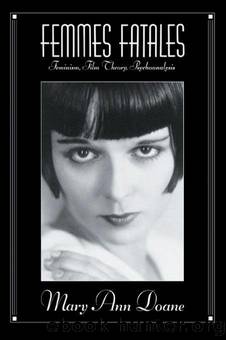Femmes Fatales by Mary Ann Doane

Author:Mary Ann Doane [Doane, Mary Ann]
Language: eng
Format: epub
ISBN: 9781136639043
Publisher: Taylor and Francis
Published: 2013-06-17T04:00:00+00:00
III. The Body of the Avant-Garde
CHAPTER EIGHT
Woman’s Stake: Filming the Female Body
We know that, for want of a stake, representation is not worth anything.
—Michèle Montrelay
To those who still ask, “What do women want?,” the cinema seems to provide no answer. For the cinema, in its alignment with the fantasies of the voyeur, has historically articulated its stories through a conflation of its central axis of seeing/being seen with the opposition male/female. So much so that in a classical instance such as Humoresque (1946), when Joan Crawford almost violently attempts to appropriate the gaze for herself, she must be represented as myopic (the moments of her transformation from spectacle to spectator thus captured and constrained through their visualization as the act of putting on glasses) and eventually eliminated from the text, her death equated with that of a point of view. Cinematic images of women have been so consistently oppressive and repressive that the very idea of a feminist filmmaking practice seems an impossibility. The simple gesture of directing a camera toward a woman has become equivalent to a terrorist act.
This state of affairs—the result of a history which inscribes women as subordinate—is not simply to be overturned by a contemporary practice that is more aware, more self-conscious. The impasse confronting feminist filmmakers today is linked to the force of a certain theoretical discourse which denies the neutrality of the cinematic apparatus itself. A machine for the production of images and sounds, the cinema generates and guarantees pleasure by a corroboration of the spectator’s identity. Because that identity is bound up with that of the voyeur and the fetishist, because it requires for its support the attributes of the “non-castrated,” the potential for illusory mastery of the signifier, it is not accessible to the female spectator, who, in buying her ticket, must deny her sex. There are no images either for her or of her. There is a sense in which Peter Gidal, in attempting to articulate the relationship between his own filmmaking practice and feminist concerns, draws the most logical conclusion from this tendency in theory:
In terms of the feminist struggle specifically, I have had a vehement refusal over the last decade, with one or two minor aberrations, to allow images of women into my films at all, since I do not see how those images can be separated from the dominant meanings. The ultra-left aspect of this may be nihilistic as well, which may be a critique of my position because it does not see much hope for representations for women, but I do not see how, to take the main example I gave round about 1969 before any knowledge on my part of, say, semiotics, there is any possibility of using the image of a naked woman—at that time I did not have it clarified to the point of any image of a woman—other than in an absolutely sexist and politically repressive patriarchal way in this conjuncture.1
This is the extreme formulation of a project which can define itself only in terms of negativity.
Download
This site does not store any files on its server. We only index and link to content provided by other sites. Please contact the content providers to delete copyright contents if any and email us, we'll remove relevant links or contents immediately.
| Ancient & Classical | Arthurian Romance |
| Beat Generation | Feminist |
| Gothic & Romantic | LGBT |
| Medieval | Modern |
| Modernism | Postmodernism |
| Renaissance | Shakespeare |
| Surrealism | Victorian |
4 3 2 1: A Novel by Paul Auster(11033)
The handmaid's tale by Margaret Atwood(6836)
Giovanni's Room by James Baldwin(5870)
Big Magic: Creative Living Beyond Fear by Elizabeth Gilbert(4718)
Asking the Right Questions: A Guide to Critical Thinking by M. Neil Browne & Stuart M. Keeley(4566)
On Writing A Memoir of the Craft by Stephen King(4205)
Ego Is the Enemy by Ryan Holiday(3982)
Ken Follett - World without end by Ken Follett(3968)
The Body: A Guide for Occupants by Bill Bryson(3789)
Bluets by Maggie Nelson(3705)
Adulting by Kelly Williams Brown(3663)
Guilty Pleasures by Laurell K Hamilton(3578)
Eat That Frog! by Brian Tracy(3505)
White Noise - A Novel by Don DeLillo(3430)
The Poetry of Pablo Neruda by Pablo Neruda(3358)
Alive: The Story of the Andes Survivors by Piers Paul Read(3302)
The Bookshop by Penelope Fitzgerald(3220)
The Book of Joy by Dalai Lama(3212)
Fingerprints of the Gods by Graham Hancock(3206)
